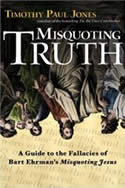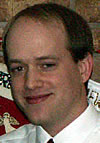Book Review: Misquoting Truth
Jones, Timothy Paul. Misquoting Truth: A Guide to the Fallacies of Bart Erhman’s “Misquoting Jesus.” Downers Grove: IVP Books, 2007. Paperback, 175 pages. $13.00.
(Review copy courtesy of IVP Books.) Purchase: IVP | WTS | CBD | Amazon
Purchase: IVP | WTS | CBD | Amazon
ISBNS: 0830834478 / 9780830834471
Download a study guide for this title.
Excerpt: Introduction: A New Breed of Biblical Scholar
View the Table of Contents
Subjects: Apologetics, Biblical Criticism
Timothy Paul Jones (Ed.D.) is professor in the School of Leadership and Church Ministry at The Southern Baptist Theological Seminary in Louisville, Kentucky. Formerly senior pastor of First Baptist Church of Rolling Hills in Tulsa, Oklahoma, he is the author of Finding God in a Galaxy Far, Far Away; Praying like the Jew, Jesus; Answers to The Da Vinci Code; Prayers Jesus Prayed; Christian History Made Easy and (with James Garlow and April Williams) the bestselling The Da Vinci Codebreaker.
The latest attacks on Christianity are bringing us best-selling books and motion pictures like The Da Vinci Code. In recent years author Bart Ehrman, a New Testament scholar with a Ph.D. in Divinity from Princeton Theological Seminary, released a best-selling book titled Misquoting Jesus. While writing portions of the book Answers to The Da Vinci Code and The Da Vinci Codebreaker, Timothy Paul Jones came across Ehrman’s book. Misquoting Truth is Jones’s response to Ehrman’s book.
This book is organized into two major sections. Jones begins by addressing why the New Testament, as we know it today, can be trusted. In this first section, he goes over how copies of manuscripts were created. Also we learn “Textual Criticism 101,” which shows how there can be differences in the manuscripts we have today and how we can determine what the original said. For example, on page 32 he tells us that asking the question “Does everything in Scripture and in the biblical manuscripts agree word-for-word?” has a problem. “That person is asking the wrong question.” He explains, “Instead, the question should be, Though they may have been imperfectly copied at times and though different writers may have described the same events in different ways, do the biblical texts that are available to us provide a sufficient testimony for us to understand God’s inspired truth?” In chapters 3 and 4, he gives many examples of verses that are often brought up as being ones that have been changed since the originals were created.
In the second section, Jones covers the “lost gospels.” He explains oral history and discusses the oft-used analogy of phone tag. A message is given and whispered from person to person; when the final person receives the message, the original message is no longer present. He then talks about the authors of the Gospels. For example, how do we know Matthew wrote Matthew and Luke wrote Luke? He goes on to talk about eyewitness evidence in the Bible. He explains the importance of eyewitnesses when it comes to the creditability of the Gospels. Finally, he gives us the answer so many Christians and non-Christians ask. How were the books of the New Testament chosen? Jones tells us about the early church fathers and their thoughts. He gives us a nice chart of early excepted canons. To top it off, he even tells us about talking crosses. Sorry, you’ll have to read the book to find out more about that.
One thing I appreciated in this book are the little extras included on several of the pages. Some pages contain a “Fact Sheet” that gives a list of facts on the subject being talked about. An example would be about who Bart D. Ehrman is. Others have a “Look It Up” section, containing definitions of terms the average Christian may not know, such as “textual criticism” and “autograph.” Two other extras are the “Know More” segments that give clear and simple-to-understand facts relating to what is being discussed and “Think About It,’ which gives quotes or asks questions to cause the reader to think about the information presented. It is these extras and how the book is written overall that make this book easy to understand, even for Christians who normally wouldn’t know all the terms being used or just may be too overwhelmed with books on subjects such as these.
I find that Jones takes a fair approach when addressing Ehrman’s book. He is respectful and sometimes generous, even more than I think he should be. For example, Jones says that “When it comes to Luke 23:34—as well as several other expansions in the Gospels—it appears that the copyist incorporated a familiar tradition that had already circulated among the churches for several decades” (p. 62). I believe there is little evidence to support the idea that the verse, as is seen in most translations, is incorrect. Also in chapter 4, Jones, in my opinion, is too quick to give credit to the Codex Sinaiticus and Codex Vaticanus manuscripts. I am not a King James Only believer, but I do think we need to be careful when putting chunks of the Bible into question. These are sections of the Bible that are seen in the majority of the manuscripts and have been passed down over the centuries. Because a small handful of manuscripts are older and have a shorter reading doesn’t mean they are right. This is an important topic related to this book, and I would recommend that people look more into this topic as further study.
Overall I find the book to be an easy read that gives a good amount of information. It will help many to answer questions relatives and coworkers may bring up when reading a book such as The Da Vinci Code or after seeing a movie based off one of the books. It may even answer questions we have in our own minds. I wouldn’t hesitate to pass this book on to a skeptical friend to read. Timothy Jones shows us the fascinating Bible history every Christian should know about. The Bible says in 1 Peter 3:15, “But sanctify the Lord God in your hearts: and be ready always to give an answer to every man that asketh you a reason of the hope that is in you with meekness and fear.” The book is fair and full of truth—something Ehrman’s book lacks.
 Matthew Christensen is a support and I.T. professional for a software company in Bloomington, Minnesota. He is married to Christa, and they have a son named Malachi. Together they run the online ministry Issues That Matter and volunteer at Fourth Baptist Church (Plymouth, MN). Matthew Christensen is a support and I.T. professional for a software company in Bloomington, Minnesota. He is married to Christa, and they have a son named Malachi. Together they run the online ministry Issues That Matter and volunteer at Fourth Baptist Church (Plymouth, MN). |
Click here to learn more about SharperIron book reviews.
- 19 views


Discussion